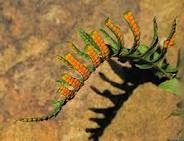Common Polypody is a fern of the Polypodiaceae family and is native to Britain Europe through to the Mediterranean region, temperate Asia and the eastern parts of North America . It is found in shady, moist places and on old walls and rocks. It grows from a creeping rhizome which has been most frequently used in traditional herbal medicine in Europe .
It is a British native fern along with bracken, moonwort, hart’s tongue, adder’s tongue and spleenwort. It was a familiar sight when I was growing up in south Wales
 The rhizome is best when harvested in autumn, in October or November and used fresh or dried. The European Medicines Agency published a report on its traditional use in 2008 and as it has been safely used for more than thirty years as a mild laxative it is considered to be safe, although not recommended for use by children under twelve years old or during pregnancy or breastfeeding. It has been used for a number of purposes including for jaundice and hepatitis, indigestion and stomach upsets, to promote appetite, for respiratory problems, as a diaphoretic, diuretic and expectorant, although it should be remembered that it does have mild laxative problems. The EMA recommend that it should not be taken for longer than a week. It may cause a rash so is not recommended for external use and it can sometimes cause a rash which is not harmful when taken internally. (Assessment Report on Polypody vulgare, L., Rhizoma EMA,
The rhizome is best when harvested in autumn, in October or November and used fresh or dried. The European Medicines Agency published a report on its traditional use in 2008 and as it has been safely used for more than thirty years as a mild laxative it is considered to be safe, although not recommended for use by children under twelve years old or during pregnancy or breastfeeding. It has been used for a number of purposes including for jaundice and hepatitis, indigestion and stomach upsets, to promote appetite, for respiratory problems, as a diaphoretic, diuretic and expectorant, although it should be remembered that it does have mild laxative problems. The EMA recommend that it should not be taken for longer than a week. It may cause a rash so is not recommended for external use and it can sometimes cause a rash which is not harmful when taken internally. (Assessment Report on Polypody vulgare, L., Rhizoma EMA,  |
| spores |
Traditionally the root has been used as a poultice for rheumatic swellings, for hives, sore throats and stomach upsets. In the past a tisane or infusion was used to drive away melancholy and for scurvy (vitamin C deficiency); when it was combined with the common mallow or the marsh mallow it was used for hardness of the spleen and pains in the side (stitches). It has also been used over a period of time for skin diseases.
The infusion was made with ½ ounce of the crushed roots to one pint of boiling water, left to steep for 10 minutes before straining and using in teacupfuls throughout the day as an expectorant, laxative and to promote appetite. Honey was used to sweeten it if necessary.
The root has a sweet taste although this is quickly cloying and has been used as a liquorice adulterant. The distilled water of the root was used for fevers as a diaphoretic, to promote sweating.
The fern fronds are mucilaginous and the mature ones, collected in autumn were boiled with coarse sugar or gur (jaggery) and the resultant liquid was given to children with whooping-cough.
John Gerard the English herbalsit who translated the works of ancient herbalists has this to say of this fern:-
“Johannes Mesues reckoneth up Polypodie among those things that do especially dry and make thin: peradventure he had respect to a certain kind of arthritis or ache in the joints: in which not one part but many together most commonly are touched: for which it is very much commended by the Brabanders and other inhabitants about the river Rhene and the Maze. Furthermore Dioscorides saith that the root of Polypodie is very good for members out of joint and for chaps between the fingers.”
 |
| polypody spores |





Great article, full of information. Thank you for sharing this knowledge. Morag Donald
ReplyDelete